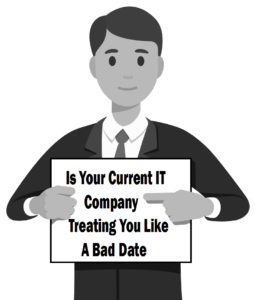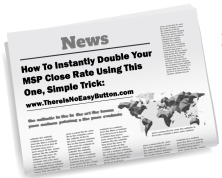 As Ogilvy famously said, “On the average, five times as many people read the headline as read the body copy. When you have written your headline, you have spent 80 cents out of your dollar.” John Caples wrote, “If the headline is poor, the copy will not be read. And copy that is not read does not sell goods.” All true.
As Ogilvy famously said, “On the average, five times as many people read the headline as read the body copy. When you have written your headline, you have spent 80 cents out of your dollar.” John Caples wrote, “If the headline is poor, the copy will not be read. And copy that is not read does not sell goods.” All true.
The biggest and single most important lead generation tip and trick is the headline copy. As a copywriter, I know the headline MUST stop the reader in their tracks and draw them in; after all, if you cannot get the reader’s attention, NOTHING else you’re saying or offering matters. Yet how many so-called advertisers actually know and practice this? Woefully few. Here’s a list of headlines for an industry publication designed to generate leads. Tell me if any of these grab your attention and cause you to want to read (or respond!) to the advertisement:
“Flexible Business VoIP”
“Technology Will Take You Far”
“Better. Faster. Greener.”
“Experience”
“Journey Together. Journey Further.”
Can you tell me from any of these headlines what’s being advertised? Who it’s for? What’s the benefit? My intention is not to embarrass the advertisers, but to make a point: these ads fail at the most basic copywriting and direct response fundamentals. Maybe they can afford a low-to-non-performing ad, but can you? So, a few lead generation tips and tricks to remember:
1. Don’t be VAGUE. This is the biggest mistake I see over and over again. There are people – marketing people – writing lead-generating ads who don’t know how to communicate a benefit and are too lazy to do a *little* research on how to write a good headline (heck, a quick Google search will get you a list of top-performing headlines that you could model…and it’s free). Because they’re clueless, they opt for “cute and clever” or overly simplistic, obtuse statements like “Technology Will Take You Far.” For example, the ad with that headline featured no other explanation. Just a picture of a server and a URL. Nothing else. Why on earth would any of you go to that URL with absolutely no promise of a benefit, no curiosity created, no clarity on what it is they are selling or who they are selling to? You wouldn’t. It’s a total and complete waste.
2. FLAG the prospect you want. This is not a hard-and-fast rule because there are lead-generating headlines that work extremely well without flagging the prospect, but more often than not it’s a GOOD idea. Flagging is identifying WHO you want in the advertisement. For example, “Start-up MSPs: Discover The Exact Marketing Plan To Get You From $0 To $1 Million Fast.” Not only does this flag the “who” but it also delivers a promise of what you’ll get.
3. Make a bold claim. “Shrink Your IT Spend With This Simple Approach” is a good headline. Add on a flag and it’s even stronger: “Nashville Construction Companies: Shrink Your IT Spend With This Simple Approach.” Using numbers in a headline also works well because it helps to arouse curiosity: “5 Words That Convince Any CEO To Increase Their IT Budget Instantly” or “3 Ways Salespeople Unknowingly INVITE Objections, Fee Resistance And The Dreaded ‘We’ll Think It Over’ Response.” Another bold-claim headline example is “Get Twice The Cyber Security Protection At Half The Cost” or “FINALLY: An Application Development Firm That Will Deliver A Bug-Free Product On Time And On Budget.” Another: “How To Get Top-Level IT Support And Cyber Security Protection WITHOUT The Heavy Cost Of A Full IT Department.” You get the idea…
4. Use curiosity. This is one of my most favorite headline formulas: curiosity. If you want an awesome free swipe file of powerful “curiosity-driven” headlines, check out the cover of any Men’s Health magazine or Reader’s Digest. Their cover “teasers” are headlines written by pro copywriters that can easily be modeled. Online, they call ads that use curiosity headlines “clickbait” for obvious reasons. They’re irresistible. The problem with clickbait is that the article or page lets the reader down – but if you can use “clickbait” curiosity AND pair that with a good, solid sales proposition, you have a winner. The “Bad Date” campaign uses this in the headline: “Is Your Current IT Company Treating You Like A Bad Date?” It then goes on to outline a very compelling argument.
Related: Marketing Deep Dive: The “Bad Date Campaign”
 Here’s the headline litmus test for these types of lead generation campaigns (not necessarily e-mail subject lines and the home page of your website): if you put a URL or phone number below it, without anything else, would a prospect respond? If not, you need to work on it. For example: How To Instantly Double Your MSP Close Rate Using This One, Simple Trick: www.ThereIsNoEasyButton.com
Here’s the headline litmus test for these types of lead generation campaigns (not necessarily e-mail subject lines and the home page of your website): if you put a URL or phone number below it, without anything else, would a prospect respond? If not, you need to work on it. For example: How To Instantly Double Your MSP Close Rate Using This One, Simple Trick: www.ThereIsNoEasyButton.com
To get a FREE step-by-step plan to consistently and predictably attract more high-quality clients for your IT services business…and put the entire system on auto-pilot, click here now!



